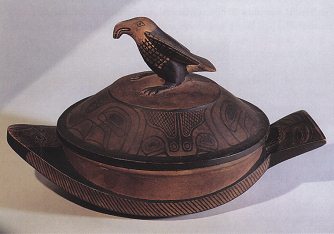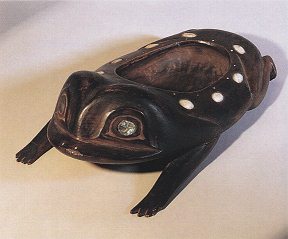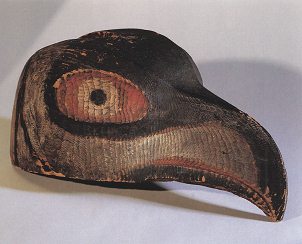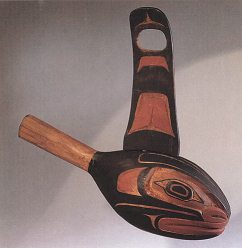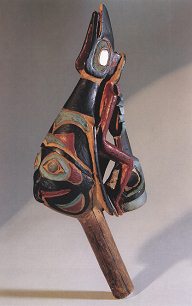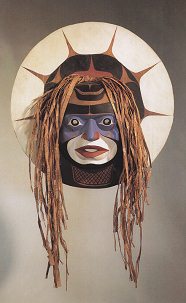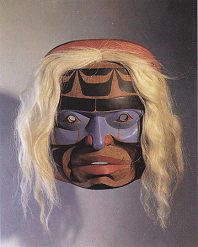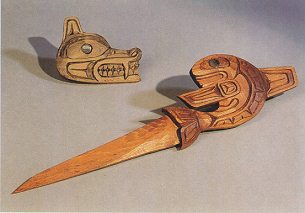North "American" Primary Nations Museum (North America Native Museum) Zurich
12. Wood carving at North West coast and with Hopi and Iroquois primary nations
Eagle mask, eventually from Haida primary nation (photo 1)
Ceremonial hat with fish and rider, Tlingit primary nation (photo 8)
presented and translated by Michael Palomino (2012)
| Share: |
Facebook |
|
Twitter
|
|
|
|
from:
Prestel museum guide, text by Denise Daenzer and Tina Wodiunig: Native Museum of Zurich (orig. German: Indianermuseum Zürich / Indianermuseum der Stadt Zürich); Prestel edition; Munich, New York 1996; supported by Cassinelli Vogel foundation, Zurich, by MIGROS percent for culture, by Volkart foundation in Winterthur; ISBN 3-7913-1635-4
<North "American" Primary Nations Museum (North America Native Museum) Zurich -- Wood carving
[North West coast (from Vancouver to Alaska) - Hopi - Iroquois]
The ideas of native wood carving are connected above all with the cultures of North West coast [today between Vancouver and Alaska], but real and ornamental forms of modeling are reminding sometimes also to East Asian and Oceanian models. Aside of North West coastal populations only the Hopi primary nation in South West (kachina figurines, see p.37ff.) and Iroquois primary nation of North Eastern forest land are famous for their carving works. Iroquois above all are masters in carving face masks.
[Relative wealth at North West coast with salmon and forest - development of wood carving]
For humans at wooded North West coast wood was an important natural resource, and rich salmon grounds and richness of other marine animals made a sedentary life possible in a relative wealth. This leaded to a privileged class of "royals" demonstrating this status presenting their possession or giving away a part or even destroying a part of it. And realizing these habits the royals needed representative goods, and therefore the wood carver and artists got their work.
[Wood carving with designs of spiritual beings or goddesses in form of animals]
In life of North West coast populations the daily life and art were not strictly separated. In these societies, art had to fulfill it's task, had to give a message. Therefore for example also tools and instruments of daily life were upgraded by artistic variations, with figurative forms and only seldom geometrical forms, and animal figurines appear in realistic or in fantasy way. This can be seen by the meaning of the many spiritual beings and goddess [extraterrestrials and astronauts] who have appeared in form of animals. Every culture had it's own mythical figure and animal spirits, and often they were represented in stylized or abstract symbols and designs. It was not necessary showing the whole body, but some characteristics were enough. Therefore a giant killer wale is characterized by it's marking dorsal fin, beaver by it's incisors or by it's great scaly tail, raven by it's typical beak, and a bear by it's powerful mouth with pointed teeth.
The relief at the outer side shows from the left to the right a wolf, two birds, a human face, and a green frog. At the other side there are carved an otter, an orca and a Thunderbird, on the inner side at the head end is a bird's head.
Artistic objects of North West coast, above all the masks and other ceremonial objects, were already in early times the most wanted collectibles. But today these objects are normal, getting good prices in auctions. for example there can be a bowl for train oil or for other food in form of a seal, made of cedar wood which was a precious element in a native household. Mostly there was prepared train oil or wale oil as dip for dried fish or peaces of meat. Also the wooden bowl in form of a plaice with an eagle on the top of the tap shows the priority for animal designs (photo 5) (p.65). With these examples the animals are not only represented illustratively but the whole object is comprised as an animal object.
Carved daily objects in animal shapes
Head ant tail of a plaice are forming the handles of this bowl, and the handle of the tap is an eagle.
Vessel for eating made of cedar wood in form of a frog.
[Design "filling the surface"]
The artists of North West coast did not want empty surfaces (Latin: "horror vacui") and used for this standard "surface fillers". An oval design represents normally eyes and joints. Designs in form of an U represent mostly ears, snouts and feathers, but also dorsal fins and tail fins of fishes or mammals. The inner parts of the animals as ribs, spine and viscerals were represented in a "radio graphing X-ray style" filling the space between the border lines. Whereas the artists had many possibilities for variations the predesigned lines and figures, the aim was not a personal style. But of course they developed many regional style variations. There were more expressive works of southern groups of Kwakiutl, Nootka and Salish, and there were more real wood carving works of Tlingit, Tsimshian and Haida in the North. Intensive cultural exchange between the families and tribes provoked that the regional differences of normal designs were blurring more and more
[Totem poles (family poles)]
Most known wooden carvings of North West coast are totem poles showing schematized animal designs. These animals are not totem animals but heraldic animals and symbols of honor of the pole owner. These poles were erected - with height of up to 15 meters - during certain events:
-- on the occasion of a house construction,
-- of the death of a high ranked person, or
-- of a burial of family members.
Sometimes, the caverned poles served as burial sites putting the dead body into the caverned pole. But these totem poles are also used
-- as welcome message being erected at river sites or lake sites for welcoming guests, or also can be as it is in front of the Zurich Native Museum at the entrance welcoming visitors.
[Description of the former totem pole of ancient Native Museum of Zurich]
(The "Zurich" totem pole was shaped by Mark George, a native artist from North Vancouver. There are an orca and a native carved and painted).
[Unfortunately there is no photo of this former Zurich totem pole in the museum guide nor in the internet].
[Wooden Masks]
Also masks are wide spread articles and artistic works of the North West coast. In the North they had an important role above all during festivities and dances and during potlatch - the present distribution festivity. The chief of a family or of a clan was wearing mostly a mask representing his heraldic animal. Dancers representing myths of clans and tribes had different masks according to their role.
Wooden masks of primary nations of the upper North West coast (today Canada)
The lower part of the beak and the tongue can be moved.
Cedar wood was the material of this mask of 19th century. The mask was worn on the head; originally there was a fabric covering the neck on it's back side.
In the south there is living Kwakiutl primary nation [on Vancouver island] and they are well known for their striking masks. They represent monsters similar to birds [probably these are extraterrestrial bird gods!] and other supernatural beings being in connection with ritual cannibalism.
[The legend about the giantess "Tsonokwa"]
Modern variation of an old motive shows the "Tsonokwa" mask (photo 4) representing a legendary giantess who was living in far mountain and forest regions (p.66). [...] Tsonokwa is bringing richness and luck. In her house there were many boxes concealed full of treasuries, and children found these treasuries who were foreseen to be visited.
[The version of Tsonokwa catching and eating children not walking fast and with half closed eyes is NOT possible because children don't allow to be catched by a woman who cannot run. The version as cannibal probably is a "Christian" racist stupidity only concealing mass murder during the own "Christian" wars].
[Ceremonial hat of Tlingit primary nation - a legend of an orca]
Ceremonial hats and head ornaments and helmets are similar works to the mask carving works. They are documenting emblems, legends or episodes of a clan's history. For example who had the ceremonial hat of cedar wood (photo 8) on it's head came from the orca clan of Tlingit. The representation had a legend as it's source describing an orca which was a friend of the humans and obviously permitted climbing on it's back for travels from island to island - fixing at it's dorsal fin.
Wearer of this ceremonial hat of cedar wood came from the orca clan. The source for the scenery is a legend describing an orca being friendly to humans permitting the transport from island to island on it's back.
[Ceremonial rods and rattles]
There were more carved objects as for example the ceremonial rods being used by high personalities during speeches or during certain rituals. and there are carved figurines representing protection ghosts and shamans. And there is also the wooden rattle in different forms. An interesting variation are rattles in form of a raven (photo 9) probably shaped first by Tsimshian primary nation. The object here corresponds to a widespread type symbolizing the transfer of power between humans and animals.
Examples of wooden rattles of primary nations
This rattle is of cedar wood representing another orca.
This painted wooden rattle was a wide spread type: On the raven's back is sitting a human being being in connection with a frog by his tongue. This human is hold by a kingfisher. At the other side of the rattle there is a hawk.
[Today's carver carving traditionally or developing new designs]
Today's [1996] native handicraft producers and artists are working in two different strategies. One group is loyal to the traditional forms and contents, and another group is looking for development of the tradition looking for new ways and expression possibilities. There is striking that many native artists and woman artists first are working with the traditions of the North West coast before they are working with the own cultural origin. Often there is only secondary material for the occupation with traditional work. This secondary material is literature or visiting museums (p.67).
Examples of new carving works of primary nations at the North West coast (today Canada)
This mask of 1968 is framed by a "Halo disk", a "courtyard". The hanging hair is cedar bast.
Alkuntäm, creator of humans, animals and plants, was curved in 1970. The white, flowing hair is of a horse tail.
This paper knife is also in form of an orca, and the brooch is a stylized wolf's head, both made by the wood carver Mark George from North Vancouver.
^


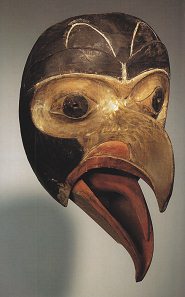
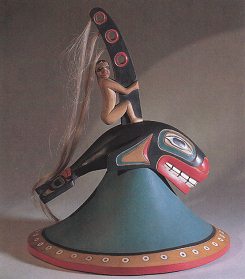
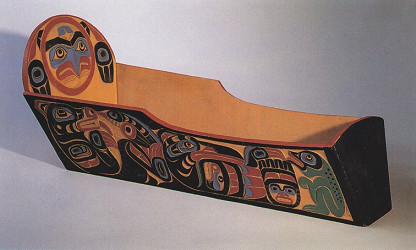
 Baby
cradle of Kwakiutl primary nation (photo 10)
Baby
cradle of Kwakiutl primary nation (photo 10)